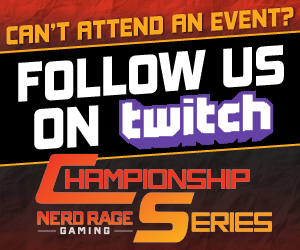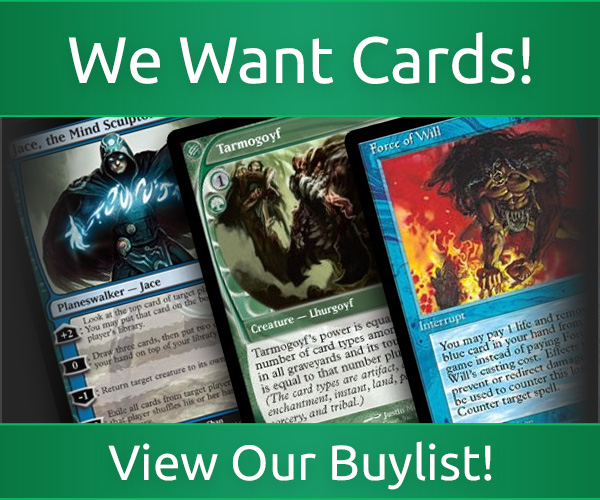Nerd Rage Gaming Presents: The State of Modern
Since its inception, Modern has been a street fight of a format.
While Standard is held (relatively) in check by its smaller card pool and Legacy has Force of Will to keep the shenanigans from getting too out of hand, the path to success in Modern has generally been to grab a 2 x 4 and start swinging.
This is reflected in the history of the Modern banned list, which has grown from its original 21 cards to 35 now. In that same timespan, only five cards — Valakut, the Molten Pinnacle; Ancestral Vision; Sword of the Meek; Bitterblossom; and Wild Nacatl — have made their way off the banned list.
from its original 21 cards to 35 now. In that same timespan, only five cards — Valakut, the Molten Pinnacle; Ancestral Vision; Sword of the Meek; Bitterblossom; and Wild Nacatl — have made their way off the banned list.
Viewing banned list announcements as a snapshot in time draws a clear picture of the history of Modern as a format.
August 2011: Modern begins as a format. The initial banned list is a Rogues’ Gallery of recent Standard enemies, including Jace, the Mind Sculptor and Stoneforge Mystic, both of which had been banned from Standard earlier in the year. Other notable entries on the list include, but are not limited to: Hypergenesis; Sensei’s Divining Top; Bitterblossom; Golgari Grave-Troll; Ancestral Vision; Glimpse of Nature; Dark Depths; artifact lands not named Darksteel Citadel; and Valakut, the Molten Pinnacle.
Pro Tour Philadelphia reveals that a few things have been missed, as busted combo decks run amok. The tournament is eventually won by Splinter Twin, an infinite combo that is less degenerate than Blazing Shoal Infect, Cloudpost strategies and Storm. To counter that, Blazing Shoal, Cloudpost, Green Sun’s Zenith, Ponder, Preordain and Rite of Flame are banned in September. Punishing Fire and Wild Nacatl are banned in December.
September 2012: Valakut, the Molten Pinnacle is unbanned, the first card to escape the Modern banned list. Scapeshift strategies become popular, but have never become the dominant deck.
January 2013: Bloodbraid Elf and Seething Song are banned, moves aimed at lessening the power of Jund and Storm, two decks that have begun to put a stranglehold on the format.
May 2013: Second Sunrise is banned due to its time-consuming, uninteractive turns that grind tournaments to a halt.
February 2014: With Jund still a dominant strategy, Deathrite Shaman, the first one-mana planeswalker in Magic history, is banned. Bitterblossom and Wild Nacatl are both unbanned; while neither becomes oppressive, Wild Nacatl quickly finds a home in Zoo and Burn decks.
January 2015: The format has stagnated into Dig Through Time, Treasure Cruise and Birthing Pod decks. All three are banned. Golgari Grave-Troll is unbanned, and Dredge begins to make appearances; the deck gets a huge boost in April of 2016, when Prized Amalgam is printed. It gets even better later in the year, when Cathartic Reunion is printed.
January 2016: Splinter Twin rules the format, and Amulet Titan decks are not far behind. Splinter Twin and Summer Bloom are both banned, crippling both strategies and theoretically opening up the format. That theory lasts until Oath of the Gatewatch unleashes Eldrazi Winter on the format, with six Eldrazi decks appearing in the top 8 of Pro Tour Oath of the Gatewatch. Eldrazi decks dominate the format until Eye of Ugin is banned in April, with Ancestral Vision and Sword of the Meek being unbanned. Neither unbanning has an earth-shaking impact on the format.
January 2017: Infect and Dredge are suffocating the life out of the format, with both decks abusing their ability to break some of the most fundamental rules of Magic. Gitaxian Probe is banned and Golgari Grave-Troll is re-banned.
Every time a new announcement was made, a particular deck quickly made its way to the top of the format, raising an uproar of cries about how “see, if Card A hadn’t been banned, Deck B wouldn’t be so good” or “how can you ban this card while still letting that card be legal?”
Until now. After this January’s bannings (and the printing of Fatal Push), something unprecedented in Modern’s history has happened: There is no consensus best deck. The format is more open than it has ever been.
While combo decks can still kill you out of nowhere on turn 4 (and sometimes turn 3) and decks like Jund and Abzan can play a grindy attrition game, Modern has finally reached something approaching equilibrium, where players can play almost anything they want and be rewarded more for understanding their deck and the format than they are for just jamming the best 75 cards available.
While there are still top decks — Affinity, Death’s Shadow and Eldrazi Tron, to name just three that have put up good results recently — they are decks that are beatable and can be hated out with a number of good answers across almost every color. The combo decks, such as U/R Storm, Scapeshift and Counters Company, can be beaten in multiple ways. Traditional Tron decks can still jam a turn 3 Karn Liberated — or fold to an early Blood Moon.
Eldrazi Tron, to name just three that have put up good results recently — they are decks that are beatable and can be hated out with a number of good answers across almost every color. The combo decks, such as U/R Storm, Scapeshift and Counters Company, can be beaten in multiple ways. Traditional Tron decks can still jam a turn 3 Karn Liberated — or fold to an early Blood Moon.
There is no Birthing Pod, no Splinter Twin, no Amulet Titan. There’s no Infect getting free wins by casting a Gitaxian Probe for free and seeing the coast is clear for a turn 2 kill. Dredge is a solid option instead of a format-wrecking disaster.
With the format in this place, at this time, it gives us an opportunity to explore its depths to find potentially hidden gems, or to evaluate the decks that are having success to see where exactly they stand in the metagame.
With that opportunity available, it gives me great pride to announce our contributions to understanding Modern as a format.
Nerd Rage Gaming Presents: The State of Modern
Over the next two weeks, we will be diving into the format to examine its top decks, both those that are putting up results and those interesting decks that may not be consistently considered as part of the top tier, but can still win a tournament in the hands of a skilled player who puts in the time to understand the format and their deck’s place in it.
Between our regular writers and a few special guests, we’ve put together a schedule of in-depth articles that will give you an unmatched perspective on Modern as it currently stands. The schedule is below; links will be added to this section as articles are posted.
Today: This overview article and an article from Level II judge Max Kahn on the interesting rules interactions that help define a judge’s perspective of Modern.
Tomorrow: Nerd Rage Gaming author and current NRG Championship Series points leader Justin Brickman on Living End.
Wednesday: Nerd Rage Gaming author Alex Hamilton, who is currently fourth on the NRG Championship Series leaderboard, on Knightfall.
Thursday: Kent Ketter, who you may recognize from his success on the SCG Tour (one Open win, seven Open top 8s, one appearance in the Players’ Championship), on Dredge. (Editor’s note: Due to circumstances beyond his control, Kent has had to withdraw from the project. The Dredge article will be rescheduled and will be replaced in this spot by Ben Meine on Jeskai Nahiri and a quick hit on Bogles by Jordan Pollack.)
Friday: Nerd Rage Gaming author Mat Bimonte on G/B/x midrange decks, specifically Jund and Abzan; Titanshift, by Nerd Rage Gaming editor Casey Laughman.
July 24: Brandon Lunt, who currently sits in fifth place on this year’s NRG Championship Series leaderboard, on G/x Tron; a quick hit on Merfolk with insight from April NRG Championship Series CTQ winner Nicholas Bradley, who won the first-ever individual CTQ with Merfolk..
July 25: Ryan Hovis on the various flavors of Death’s Shadow. Ryan piloted Sultai Death’s Shadow to a top 8 finish at the SCG Tour Modern Open in Baltimore this March, his second Open top 8. Ben Schuetzenhofer on Ad Nauseam.
July 26: Nerd Rage Gaming author Blake Smith on Burn; Mat Bimonte on Dredge; a quick hit from Brandon Lunt on Mono-U Tron.
July 27: Peter Tragos, who has five SCG Tour top 8s (three top 4s), on U/B Taking Turns; a quick hit on Affinity with insight from Alex Javed, who has qualified for both the 2016 and 2017 Nerd Rage Gaming Championships thanks to winning Modern CTs with Affinity.
July 28: Justin Kessel, who currently sits second on the NRG Championship Series leaderboard, on Eldrazi Tron; Jacob Brown on Counters Company.
It is our hope that this series of articles will help you understand the ins and outs of Modern and how the format’s top decks interact with each other. While we can’t examine every possible deck, the list that we have here will go a long way toward offering a comprehensive look at the format, where it is now, and where it is going.
I welcome your feedback and questions, either through email at claughman@gmail.com or via Twitter @caseylaughman. Thanks for reading and enjoy the next couple weeks. It’s going to be a fun ride.
Casey Laughman is editor of Nerd Rage Gaming. Email questions and comments about this series or other topics to claughman@gmail.com.



